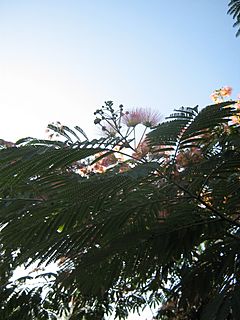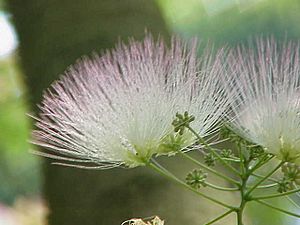Silk tree facts for kids
Quick facts for kids Albizia julibrissin |
|
|---|---|
 |
|
| Persian Silk Tree | |
| Scientific classification | |
| Kingdom: | |
| Division: | |
| Class: | |
| Order: | |
| Family: | |
| Subfamily: | |
| Genus: | |
| Species: |
A. julibrissin
|
| Binomial name | |
| Albizia julibrissin (Willd.) Durazz.
|
|
The Silk Tree (scientific name: Albizia julibrissin) is a beautiful plant. It belongs to the Albizia group of trees. This tree originally comes from parts of Asia. You can find it growing naturally from eastern Iran all the way to China and Korea.
The name Albizia honors an Italian nobleman named Filippo del Albizzi. He was the person who first brought this tree to Europe in the middle of the 18th century. Sometimes, people mistakenly spell the name as "Albizzia". The special name julibrissin comes from a Farsi phrase. It's a changed version of "Gul-i Abrisham" (گل ابریشم). This phrase means "silk flower" or "silk tree". "Gul" (گل) means "flower" and "Abrisham" (ابریشم) means "silk". This name perfectly describes its lovely, silky flowers!
Contents
What Makes the Silk Tree Special?
The Silk Tree is famous for its unique and pretty flowers. These flowers look like fluffy pink or white pom-poms. They have many long, thin stamens that give them a soft, feathery look. The flowers often bloom in the summer, making the tree very colorful.
Leaves and Appearance
The leaves of the Silk Tree are also interesting. They are made up of many small leaflets. These leaflets fold up at night or when it rains. This movement is why some people call it a "sleeping tree." The tree usually grows to be a medium size. It has a wide, flat top, which makes it a great shade tree.
Where Does the Silk Tree Grow?
This tree loves warm places. It grows well in many different types of soil. Because it's so pretty, people have planted it all over the world. You can now find it in many countries outside of Asia. It's often used in parks and gardens.
Life Cycle and Reproduction
Like many flowering plants, the Silk Tree produces seeds. After the flowers bloom, they turn into long, flat seed pods. These pods look a bit like beans. Inside the pods are the seeds. When the pods dry out, they split open. This releases the seeds, which can then grow into new Silk Trees.
See also
 In Spanish: Albizia para niños
In Spanish: Albizia para niños
Images for kids




